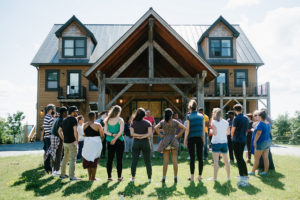 Kate Schapira shares three stories about the needs that form a community and the effort it takes to be a part of one.
Kate Schapira shares three stories about the needs that form a community and the effort it takes to be a part of one.
Late summer, 2017: for a project, I needed many small drawings of organisms that live in Rhode Island, and I didn’t have time to make enough on my own, so I put out a call for help on Twitter. A mix of old friends and newer acquaintances showed up, most from my own neighborhood, one or two from across town. They, my partner and I sat on the porch with pens, cards, field guides, and snacks as the day lengthened into evening. By the end of the night I had an ample supply of drawings: a house sparrow, a skunk, a tiger beetle. It felt like I was reaping my share of a long, patient process of growing and giving and enriching, wrangling and risk. A task tackled together, an evening of pleasant effort and company, a problem solved. Community as we dream of it, abilities meeting needs, joyously and generously, no strain and no suffering, no loss to anyone.
Early summer, 2018: the City of Providence hosted a “community conversation” on a proposed and contested plastic bag ban. Proponents point to waste and litter, plastic in the soil and the waterways; critics point out, correctly, that the major deterrent proposed (a fee per bag at many stores, especially supermarkets and pharmacies) poses an undue burden for low-income families, especially those shopping for many people. I wasn’t able to attend, but it’s evident from the summary sent out by the city’s sustainability office that no solution or anything like one was reached. For as long as it takes to figure it out—if we ever do—plastic bags will continue to make their way into the waste stream, into the city streets, into the rivers and seas, damaging the nonhuman members of the community.
Seeing community’s main work, or main quality, as solving problems together is limited, but it’s easy to fall into. Seeing community as people united primarily by a problem is also tempting, and it can be powerful both in informing identity and in making progress toward justice. But it’s also limited, for two reasons. It ignores or downplays the other elements of a sense of we, of shared being—cultural references and practices, geographical proximity, habitual contact. And it ignores the ways in which people with different problems, different needs and desires, and different privileges are also in community with one another, and the ways in which the conflicts and opportunities that come from that are the community’s conflicts and opportunities.
Early summer, 2018, again: three housemates approach the end of their lease. One of them is careless about an email chain, leading to confusion about the move-out date and a need to be fully moved out several days sooner than they all intended and expected. Another of the housemates calls in every favor she has, from multiple circles: friends, neighbors, co-workers. The move gets made, but the person who made the original mistake and created the necessity does (according to several of the other movers) a very small percentage of the actual work of moving and cleaning. The other housemates may not be friends with her after this, because of this; they may not like her; they may treat her differently. But they are all, still, part of the same community. If her needs are at odds with theirs, maybe she’ll hurt them or maybe they’ll hurt her—it depends on a few other things, like the kinds of power they each have—or maybe they’ll have, again, a chance to figure out a way of handling what everyone needs that’s just even if it’s not equitable.
What these three stories suggest to me is that a community is a group of people—human and nonhuman—who need things from each other and/or need things together. And community—being part of a community—means, to me, participating as fully and fairly as I can in that web of needs, and increasing my understanding of how to do so.

Leave a Reply